Off Beat Track : Western Iran (January 2 – 5)
Persia has captured travellers’ imagination for centuries. Iran has been on my ‘must – see’ list for decades. I joined a classic 10-day tour to Central Iran and visited Tehran, Shiraz, Yard, Esfahan, Kashan and Qom (ie the ‘In the footsteps of Empire’ route as described in the Lonely Planet) from December 23, 2010 to January 1, 2011. In addition, I spent another ten days before and after the tour to explore Western Iran.
January 2 : Tehran – Tabriz (560km; by bus)
My original plan was to spend the remaining few days to visit the Castles of the Assassins in the Alamut Valley, the Oljetu Mausoleum in Soltaniyeh (‘Town of the Sultans’) and Takht-e Soleiman. The last two are World Heritage Sites. I was advised to use Zanjan as the base. I planned to leave in late afternoon so that I could visit three museums in Tehran.
The Carpet Museum of Iran has an impressive collection of some 100 pieces coming from all over Iran, including a replica of the world’s oldest carpet (the original is in the Hermitage in St Petersburg, Russia).
The National Jewels Museum owned by the Central Bank and housed underneath the central branch of Bank Melli, is the highlight of my museum tour in Iran. The collection is incredible and probably the best of its kind in the world. I joined a free guided tour and spent over an hour admiring each of the art pieces in particular the Darya-ye Nur (Sea of Light), a 182-carat pink diamond, the Peacock Throne, the Kiani Crown and a few other crowns, the 34-kg Globe of Jewels using 51,366 stones, numerous beautiful diamonds, rubies, emeralds, sapphires etc.
January 3 : Tabriz – Kandoven – Shahin Dozh- Takab (around 400km; by taxi, bus and minibus )
Tabriz, a trade hub during the Sassanian – era and a short-lived capital under Shah Ismail, the first Safavid ruler, is famous for its bazaar, carpets and the Blue Mosque. 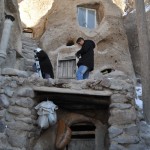
I took a taxi to Kandoven, reminiscent of Cappadocia’s fairy-chimneys in Turkey. It was a cold day and the nearby hills surrounding Kandoven were all covered in snow. It is a photogenic settlement of troglodyte homes and storage barns for less than 1000 residents. I met a group of architecture students on a field trip and told them Takht-e Soleiman would be my next stop. They spoke English and advised me to return to Tabriz to take a bus to Takab and then hire a car. The taxi driver therefore dropped me at the bus terminal which is far from the city centre. Hence I did not have a chance to visit Tabriz at all.
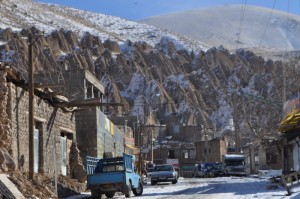 My journey to Takab turned out to be an adventure. I asked for the bus to Takab and a young man helped me purchase a bus ticket. The bus left at 2pm and I fell asleep. I woke up an hour later without knowing where I was. Around 4pm, we arrived at a small town and the driver told all passengers to get off. No one spoke English and I could only say ‘Takab?’ Another passer-by pushed me to a savaris which stopped opposite a bus terminal. With past experience, I knew I had to take another bus to Takab. Someone then stopped a minibus and told me to get on. It turned out to be the last minibus leaving for Takab before dark. I later discovered the town is called Shahin Dezh.
My journey to Takab turned out to be an adventure. I asked for the bus to Takab and a young man helped me purchase a bus ticket. The bus left at 2pm and I fell asleep. I woke up an hour later without knowing where I was. Around 4pm, we arrived at a small town and the driver told all passengers to get off. No one spoke English and I could only say ‘Takab?’ Another passer-by pushed me to a savaris which stopped opposite a bus terminal. With past experience, I knew I had to take another bus to Takab. Someone then stopped a minibus and told me to get on. It turned out to be the last minibus leaving for Takab before dark. I later discovered the town is called Shahin Dezh.
I had a wonderful 3-hour ride to Takab. The narrow winding and mountainous roads were covered in snow. When the bus was running at the top of a ridge, I saw a most beautiful sunset with pink and purple reflections on the snowy mountains and valleys. The minibus finally arrived in Takab around 7pm. A young man sat next to me, who is an army officer, kindly gave me a lift to my hotel. I met Soheila who is the daughter of the owner of the hotel. She speaks English and has completed her MBA course. She told me a lot about her hometown, her aspirations and business plan for the hotel and took me on a walking tour. I also visited their spacious 3-storey house which is beautifully decorated in Persian style. I had some homemade chicken and tea before returning to the hotel. I appreciated the hospitality and warmth of the Iranian people.
January 4 : Takab – Tehran (about 450km) (by taxi and bus)
I chartered a taxi for a day to travel from Takab to Soltaniyeh before taking a bus back to Tehran. The taxi driver was friendly though we could not communicate in English. I had a great day enjoying stunning landscape with mountains, the pyramidal peak of Tozludagh (Dusty Mountain) and villages all covered in white snow.
Zendan-e Soleiman meaning Solomon’s prison is a dramatic 97m conical peak which dominates the valley landscape. The cone with a central crater was once enclosed by walls and topped by a religious sanctuary dating back to 900 BC. I was alone and climbed to the top enjoying a superb view of the valley. Takht-e Soleiman, a 1500-year-old fortress in a magnificent setting. Zoroastrianism was the state religion in pre-Islam Persia and Takht-e Soleiman was the spiritual centre of the Sassanians (and history’s foremost Zoroastrian temple complex). It is a perfect site as Zoroastrianism venerates earth, wind, water and fire. The beautiful ‘bottomless’ crater lake forms the centre of the site surrounded by mountains. The ruins were all covered in white snow with occasional sunshine. I wandered in this lonely, surreal and dramatic site for two hours enjoying the sound of wind, superb and photogenic views of Zenan-e Soleiman and the surrounding mountains. Though it did not have Persepolis’s grand staircases and the finest carvings, I found the atmosphere and tranquility unrivalled and unforgettable. In my view, Takht-e Soleiman and Choqa Zanbil’s massive ziggurat are the two most atmospheric and impressive sites of my 21-day journey.
There was hardly any vehicle on the road from Takab to Dandy (in the direction of Zanjan) and the drive was most scenic. The landscape is stunning with expansive and dramatic snow-clad mountains, gorges and valleys. It would definitely look very different and less enjoyable if the weather’s hot with lots of tourists and vehicles on the road.
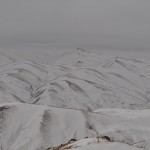 |
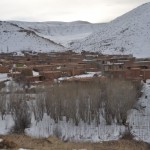 |
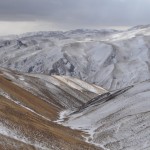 |
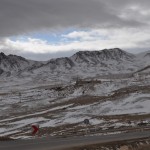 |
Soltaniyeh was built by the Mongols as their capital from AD 1302 and was largely destroyed by Tamerlane in 1384. Mongol sultan Oljeitu Khodabandeh first planned to build the mausoleum to re-house the remains of Imam Ali, son-in-law of the Prophet Mohammed thus making it into Shiite Islam’s holiest pilgrimage site outside Mecca. He did not succeed and eventually he was buried here in 1317. The dome of the Oljeitu Mausoleum measured 25m in diametre and 48m high is the world’s tallest brick dome. The terrace on the upper floor affords panoramic views across the plain with fine stucco-work vaulting.
I had a wonderful day spending the whole day sight-seeing. I had no time for a sit-down lunch. Instead, I gave my bread, cheese and biscuits to the driver. After Soltaniyeh, he took me to the roadside of the highway to Tehran and stopped a long-distance bus for me. It started to snow and I finally arrived in Tehran at 7pm.
My trip is unforgettable and inspirational. It has also opened my eyes to the grandeur of ancient Persia as well as myths and realities of Iran today.
First, Iran is a diverse land with half of the country covered by mountains which are beautiful and majestic. There are also vast desert plateaus, picturesque oases as well as mountain villages. I need to spend at least a month to explore all corners of the country. I also hope to climb Mt Damavand (5671m), which is the highest in the Middle East, one day.
Second, the Iranian people are proud of their culture and history. I have met many people when taking public transportation (ie savaris, minibus and bus) and find them sincere, honest, polite, generous and helpful. My home stay in Khorramabad and Tehran has enabled me to better understand their lifestyle and culture.
Third, the Iranian society is generally progressive and relatively ‘open’. Women enjoy more freedoms and equality than their neighbours. Polygamy is illegal. Sara, Neda and their cousins are all university students pursuing their professional studies while Soheila is running her father’s hotel in Takab. Ladies are moving around freely and many are professionals.
Fourth, the society is orderly and civilized. Iran unlike many other countries, is not crime-infested and I felt safe. There is an extensive and well-built highway system with efficient public transportation systems. I have travelled in all modes except the train. I exchanged money in both hotels and banks without problem. All the places I have visited, whether in Tehran or a small town like Kandovan, are clean and orderly.
Iran is however also a land of contrast and is facing some problems as well. Tehran with a population of over 10 million, is suffering from severe air pollution and traffic congestion. I was told Iranians are keen to own their cars. Though Tehran is going to build more metro lines, this alone will not solve the congestion and air pollution problem if people prefer to drive.
I have met many frustrated Iranians who talked about their concerns. Some support the government while others believe the government should do more. Iranian are very upset with the ‘country of evil’ label. They feel isolated and want to travel freely to see the world. But, they cannot do so easily under the current embargo on Iran. They thus want more foreigners to visit their country to better understand Iran today which is different from other Middle East and Arab countries. Pollution, inflation and unemployment are problems they hope the government can tackle and improve their quality of life.


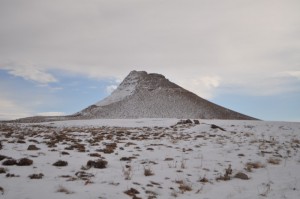
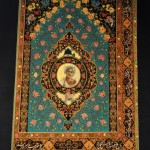

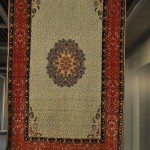
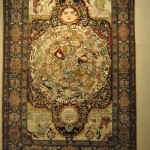
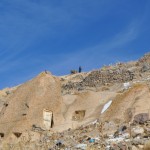
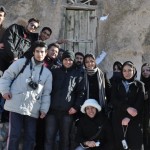
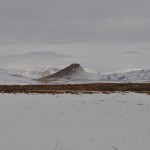
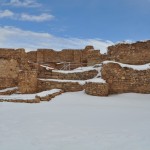
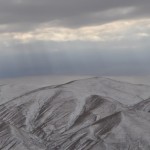
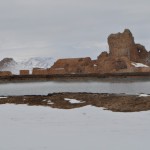
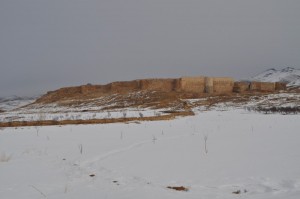
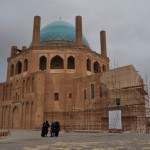
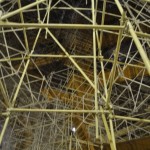
Sarah,
Reading through your 21 days in Iran, I’m impressed by the historic, cultural wealth of the country, the breath taking landscape, the friendly, open attitude of Iranians and your courage in travelling alone in a foreign land without the language. However, I failed to see the ‘smiling face’ on the tree but caught sight of ‘eyes’ on the left trunk? ‘Stone Lion’ is my pick, for it’s simplicity and nativeness. With limited knowledge, Middle East is always a ‘mystery’ to me, your experience and remarks have enhanced my understanding of Iran. (btw, I read a graphic novel titled ‘Persepolis’, an autobiography of an Iranian woman from childhood to early adulthood, during and after the Islamic revolution, Think you’ll be interested, try it.)